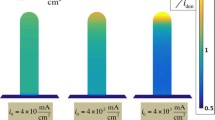Abstract
Despite growing interest in pulse current electroplating, published theories have not evolved beyond treatments of simple, single-step reaction kinetics. This omission of multiple-step kinetics and associated reaction pseudocapacitance is responsible for the inability to interpret mechanistically several key pulse current electrodeposition process characteristics.
A complex kinetics charge transfer model is developed to describe the enhanced geometric control of deposit thickness achievable with judiciously chosen pulse current control conditions. This semiquantitative analysis demonstrates that deposit thickness ‘levelling’ is primarily the result of the strong potential dependence of the reaction pseudocapacitance, together with proper choices of pulse current control variables. For any system of interest, a well defined on-time current,I A, and on-time and off-time periods,t A andt B, are optimum for minimizing relative deposit thickness variation.
Similar content being viewed by others
References
G. W. Jernstedt,Ann. Proc. Amer. Electroplaters' Soc. 36 (1949) 63.
A. J. Avila and M. J. Brown,Plating 57 (1970) 1105.
A. R. Despic and K. I. Popov,J. Appl. Electrochem. 1 (1971) 275.
C. C. Wan, H. Y. Cheh, and H. B. Linford,Plating 61 (1974) 559.
W. Sullivan,ibid.Plating 62 (1975) 139.
J. D. E. McIntyre and W. F. Peck, Jr.,J. Electrochem. Soc. 123 (1976) 1800.
Ch. J. Raub and A. Knodler,Gold Bull. 10 (1977) 38.
L. Missel and T. Montelbano,Electron. Packag., April, (1978) 166.
N. Ibl,Surf. Technol. 10 (1980) 81.
L. Missel, P. Duke, and T. Montelbano,Semiconductor Int., February 67 (1980).
N. Ibl,J. Electrochem. Soc. 114 (1967) 1268.
N. Ibl, J. C. Puippe and H. AngererSurf. Technol. 6 (1978) 287.
H. Y. Cheh,J. Electrochem. Soc. 118 (1971) 551.
K. Viswanathan, M. A. Farrell Epstein, and H. Y. Cheh,ibid.J. Electrochem. Soc. 125 (1978) 1772.
K. Viswanathan and H. Y. Cheh,ibid.J. Electrochem. Soc. 125 (1978) 1616.
K. Viswanathan, H. Y. Cheh and G. L. StandartJ. Appl. Electrochem. 10 (1980) 37.
H. Y. Cheh, International Society of Electrochemistry, 35th Meeting, Abstract B6-6.
H. E. Hager, in preparation forJ. Appl. Electrochem.
Author information
Authors and Affiliations
Rights and permissions
About this article
Cite this article
Hager, H.E. Current levelling behaviour under pulse current electroplating conditions: The role of reaction pseudocapacitance. J Appl Electrochem 16, 189–195 (1986). https://doi.org/10.1007/BF01093350
Received:
Revised:
Issue Date:
DOI: https://doi.org/10.1007/BF01093350




